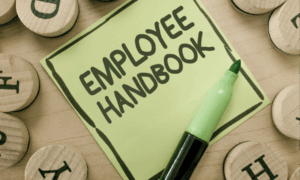This is a sample Coronavirus Action Plan. It is not meant to be exhaustive or construed as legal advice. Consult additional insurance and/or legal counsel for professional advice. Please modify this action plan to meet your business needs, taking all relevant federal, state and local compliance requirements into account.
The coronavirus (COVID-19) outbreak has impacted businesses across a variety of industries, forcing them to rethink their daily operations to ensure the safety of their employees and the general public. This is no different for retail operations, where multiple workers may come into contact with innumerable customers visiting the store throughout the workday. In these instances, just one misstep can lead to the quick spread of COVID-19, jeopardizing the well-being of workers.
To help slow the spread of COVID-19 and safeguard our staff, has created an action plan for responding to COVID-19. This plan, which is based on Centers for Disease Control and Prevention (CDC) and Occupational Safety and Health Administration (OSHA) guidance, highlights the responsibilities of managers and employees, and outlines the steps is taking to address COVID-19.
RESPONSIBILITIES
When it comes to ensuring a safe workplace during the COVID-19 outbreak, both managers and employees have their role to play. The following is a breakdown of the responsibilities for leadership and staff.
Managers and Supervisors
Leadership, including managers and supervisors, should familiarize themselves with the details of the action plan. Above all, leadership must be prepared to answer questions from employees and set a good example by adhering to the guidance prescribed in the plan. This involves practicing social distancing and good personal hygiene.
Employees
Employees play a critical role in ’s COVID-19 prevention efforts. To protect everyone in the store, has a number of general best practices employees should follow:
- Understand the signs and symptoms of COVID-19, and stay home if you are feeling sick—Any employee who is experiencing symptoms of COVID-19 (e.g., fever, cough, shortness of breath, sore throat, runny nose, body aches, chills or fatigue) should stay home. Individuals experiencing such symptoms should also be instructed to consult guidance from the CDC on seeking medical care.
- Practice good hygiene—Employees should clean their hands often, either with an alcohol-based hand sanitizer or soap and water. Hand sanitizers should contain at least 60%-95% alcohol, and employees should wash their hands with soap for at least 20 seconds. In addition, employees should avoid touching their face and cough into their arm.
- Practice social distancing—Social distancing is the practice of deliberately increasing the physical space between people to avoid spreading illness.
For specific employee safety protocols, click here.
Pandemic Response Team
The pandemic response team is a cross-functional team that recommends and oversees workplace protocols to control the spread of COVID-19. The team will include the following roles:
- Store manager—[Insert name of individual or department] is responsible for the store’s overall action plan. [Insert name of individual or department] is responsible for working with company stakeholders and relevant health and safety bodies to manage this action plan.
- Virus prevention and protocols lead—[Insert name of individual or department] is responsible for recommending and developing protocols to ensure the wellness of all employees. They are also tasked with overseeing procedures for isolating employees should they become sick at work.
- Sanitization and disinfection lead—[Insert name of individual or department] manages logistics related to daily and periodic sanitation and disinfection efforts. Their responsibilities include ensuring that routine cleanings are completed and that the necessary cleaning supplies are readily available.
- Communication lead—[Insert name of individual or department] is tasked with managing any and all pandemic-related communications. They will work with human resources and internal communication stakeholders to ensure COVID-19 training is completed and that employees and their managers understand their role in preventing the spread of the disease. [Insert name of individual or department] will provide COVID-19 related updates on a [Insert frequency] basis and as needed.
STORE OPERATION PROTOCOLS
In order to keep staff safe and prevent the spread of COVID-19, requires the following workplace protective measures:
General Safety Policies
- Employees and customers who exhibit signs or symptoms of COVID-19 will be asked to leave the store.
- Access to handwashing stations and alcohol-based hand sanitizers will be provided to employees. [Insert details]
- Protective barriers will be installed at checkout locations and to promote employee and customer safety. [Insert details]
- Employees can voice concerns COVID-19 concerns by [Insert details].
- Travel will be limited for multi-store personnel. [Insert details]
- may decrease open business hours to perform more frequent cleanings.[Insert details]
- will limit the number of customers allowed in our store at any one time to [Insert details. Take state and local rules into account].
- In order to protect staff when working around customers, may provide:
- Gloves—Employees may contract COVID-19 by touching contaminated surfaces and then touching their face. Gloves are an effective way to prevent COVID-19 from getting on an employee’s skin. They are also a good reminder for employees not to touch their face.
- Face masks—Viruses can be transmitted through the mouth via tiny viral particles known as aerosols. Face masks can help protect employees from these particles.
Protocols for Workers
To ensure safety at stores, employees will be asked to:
- Notify their supervisor and stay home if they are experiencing COVID-19 symptoms (e.g., fever, cough or shortness of breath).
- Stagger lunches to limit the number of individuals congregating in break areas. may divide crews to reduce the number of workers in the store at a given time.
- Limit close contact with others, maintaining a distance of at least 6 feet when possible. Workers are encouraged to remind customers to maintain at least 6 feet of distance from workers and other customers. Above all, avoid job tasks that require face-to-face contact with others where possible. If this is unavoidable, employees will be provided with face masks, physical barriers and other workplace controls to ensure their safety.
- Wear face masks where other social distancing measures are difficult to maintain.
- Refrain from sharing equipment. In instances where this is unavoidable, will provide alcohol-based wipes and other cleaning materials that employees can use to clean equipment.
- Keep the following in mind when exchanging paper and coin money:
- Do not touch your face after the exchange.
- Ask customers to place cash on the counter rather than directly into your hand.
- Place money directly on the counter when providing change back to customers.
- Sanitize the counter between customer checkouts.
- Clean and disinfect frequently touched surfaces, including workstations, cash registers, payment terminals, door handles, tables and countertops on a regular basis.
- Practice proper hand hygiene. Wash your hands regularly with soap and water for at least 20 seconds. An alcohol-based hand sanitizer containing at least 60% alcohol can also be used. Employees should clean their hands:
- Before, during and after food preparation
- Before eating food
- After using the restroom
- After blowing their nose, coughing or sneezing
- After putting on, touching or removing face masks
- Before and after work shifts
- Periodically throughout the day
- Before and after work breaks
- After touching money or objects that have been handled by customers
- Avoid touching your eyes, nose and mouth whenever possible.
- Avoid contact with others whenever possible (e.g., handshakes).
- Avoid gathering when entering and exiting the store. Employees should also only enter and exit designated areas.
- Follow any posted signage regarding COVID-19 social distancing practices.
Protocols for Customers
In order to protect our customers and staff, will:
- Communicate our safety protocols and why we are taking specific precautions. This will be done using signage, social media and other available communication channels.
- Encourage customers to practice social distancing when in the store. Customers will be asked to maintain at least 6 feet of distance from staff and other customers via verbal announcements on the loudspeaker and written signage.
- Prohibit customers from bringing reusable bags into the store.
- Provide special hours for high-risk shoppers (e.g., seniors).
- Encourage the use of touchless payment options to minimize handling cash, credit cards and reward cards.
- Increase cleaning and sanitizing of all high-touch surfaces (e.g., ATMs, pens, touch screens and carts).
- Place hand sanitation stations and wipes throughout the store.
- Minimize person-to-person contact where possible. This could involve establishing rules regarding the number of customers allowed in the store at a given time or only allowing a set number of individuals in aisles at a time.
- Update messaging on our websites to educate customers on store precautions, digital orders and store hours.
- Move the credit card reader farther away from the cashier. This increases the distance between the customer and the cashier.
- Place visual cues, such as floor decals, colored tape or signs, to illustrate where customers should stand during check out.
- Shift primary stocking activities to after hours to reduce employee contact with customers.
- Provide remote shopping alternatives for customers, including delivery and pick-up options. Instructions for these options will be communicated clearly at the point of purchase (e.g., online or over the phone), and there will be a designated area for customer pick up.
- Clean shopping carts and baskets.
Additional Safety Policies
- [Insert CVOID-19 response protocols for specific aspects of your store’s operations].
Sick Leave Policy
- [Insert policies specific to your store’s operations].
CLEANING AND DISINFECTING PROCEDURES
- Surfaces and equipment will be disinfected at the end of each shift, before and after use, or—for frequently touched items—multiple times a day. The following items will be cleaned regularly:
- Door handles and push plates
- Restrooms
- Aisles
- Handles on all equipment doors
- Handles on beverage dispensers
- Ice scoops
- Refrigerator and freezer handles
- Plastic curtains on walk-in refrigerators and freezers
- Freezer handles
- Sink handles
- Soap dispenser push plates
- Towel dispenser push plates
- Trash receptacle touch points
- Cleaning tools
- Buckets
- Telephones
- Computers
- Office cabinet handles
- Break room tables and chairs
- Display screens on equipment
- All stainless steel surfaces
- Thresholds and hand railings
- Shopping carts and baskets
- Counters
- Cash registers
- Display cases
- Self-service areas
- Point-of-sale registers
- Kiosks
- Frequently touched shelving, displays, and reach-in refrigerator units
- Sneeze guards
- Baby changing stations in restrooms
- Pens or other writing utensils
- Clipboards
- Electronic signature pads
- Elevator buttons
- Surfaces inside delivery vehicles
- Stocking equipment
- Employee linens
- Employees responsible for cleaning will be given the appropriate protective equipment. Cleaning should be completed using CDC-recommended products, including:
- Environmental Protection Agency-registered household disinfectants
- Alcohol solutions with at least 60% alcohol
- Diluted household bleach solutions (if appropriate for the surface)
- Trash will be collected from the workplace regularly. Those collecting trash will be instructed to wear nitrile, latex or vinyl gloves.
- HVAC air filters will be cleaned and disinfected regularly.
- Hand sanitizer dispensers will be refilled frequently.
- When an employee has tested positive for COVID-19, deep cleaning will be triggered and will ensure areas in which the individual worked are cleaned thoroughly. In regard to deep-cleaning practices:
- will identify an approved external company to complete a deep cleaning of the facilities. This external company will be equipped with the proper training, permits and cleaning equipment to complete the task.
- The pandemic response team will coordinate and supervise deep-cleaning efforts to ensure:
- There is a specific plan and strategy in place, and that plan accounts for all machinery, equipment, common areas, tools and offices.
- Authorized individuals are the only ones allowed access to the site during the deep cleaning.
- Employees are aware of deep-cleaning practices.
- The company contracted to perform the deep cleaning uses the appropriate PPE during the process and disposes of potentially contaminated items properly.
EXPOSURE SITUATIONS
has response plans in place for situations when employees exhibit symptoms of or test positive for COVID-19.
Employee Exhibits Symptoms of COVID-19 Before Entering the Store
- The employee reports their symptoms to their supervisor, who then communicates that an employee is exhibiting symptoms of COVID-19 to the relevant parties (e.g., human resources).
- The employee is given a face mask and gloves, and is sent to a designated isolation room for further evaluation by the virus prevention and protocols lead or another designated individual. This evaluation will examine an employee’s symptoms in more detail, flagging employees who are experiencing the following:
- A fever of 100.4 F or higher
- Shortness of breath or difficulty breathing
- A cough
- A runny nose
- Muscle pain
- Tiredness
- If COVID-19 symptoms are confirmed, employees may be asked to go home and speak with their health care provider. will ensure employees are able to get home safely before dismissing them. If, after an evaluation, the employee is not exhibiting COVID-19 symptoms, they may return to work at the discretion of the virus prevention and protocols lead.
Self-quarantining and Return to Work
Employees who test positive for COVID-19 or believe they have been infected will be instructed to follow the advice of a qualified medical professional and self-quarantine. When self-quarantining, employees should:
- Stay away from other people in their home as much as possible, staying in a separate room and using a separate restroom if available.
- Not allow visitors.
- Wear a face mask if they have to be around people.
- Avoid sharing household items, including drinking cups, eating utensils, towels and bedding.
- Clean high-touch surfaces daily.
- Continue monitoring their symptoms, calling their health care provider if their condition worsens.
Notably, employees who are symptomatic or who have tested positive should not return to work until the conditions outlined in the table below are met:
| Return to Work Considerations | |
| Employee was symptomatic but was not tested for COVID-19. | Employee was tested for COVID-19. |
| The employee may return to work if: -They have not had a fever for at least 72 hours and have not used fever-reducing medication during that time. -Coughs and other symptoms have improved. -Seven days have passed since they first experienced symptoms. | The employee may return to work if: -They no longer have a fever. -Coughs and other symptoms have improved. -They have received two negative COVID-19 tests in a row. |
When an employee tests positive for COVID-19, deep-cleaning procedures will be triggered. Furthermore, employees who have been in close contact with an individual who has tested positive for COVID-19 will be instructed to self-quarantine.
OSHA RECORDKEEPING AND REPORTING
will adhere to OSHA-mandated requirements as they relate to recording and reporting certain work-related injuries and illnesses.
QUESTIONS
If employees have any questions regarding the content of this action plan, they should be instructed to speak with their supervisor. Furthermore, while the strategies highlighted in this document can protect workers from COVID-19, it’s important to follow CDC guidance at all times. For more information, click here.






